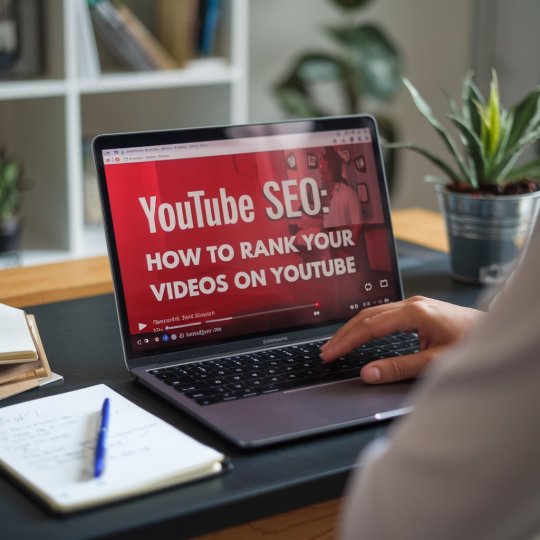Don't wanna be here? Send us removal request.
Text

1. Understanding YouTube SEO
YouTube SEO is the process of optimizing your videos to rank higher in YouTube’s search results. Like Google, YouTube uses an algorithm to determine which videos are most relevant to users’ searches. The key ranking factors include:
Watch Time: The total time viewers spend watching your video.
Engagement: Likes, comments, shares, and subscriptions.
Relevancy: How well your video matches a user’s search query.
2. Keyword Research for YouTube
Keyword research is the foundation of YouTube SEO. It helps you understand what terms people are using to search for content similar to yours.
Use Tools: Tools like TubeBuddy, vidIQ, or YouTube’s auto-suggest can help find the right keywords.
Focus on Long-Tail Keywords: These are specific, less competitive phrases that help your content rank faster. For example, instead of "yoga," you might use "beginner yoga for back pain."
Analyze Competitors: Look at the top-performing videos in your niche to find keywords you can use.
3. Optimizing Video Titles
Your title is the first thing viewers see. It must be both engaging and SEO-friendly.
Include Keywords: Your primary keyword should appear naturally in the title. Example: "Yoga for Beginners: Relax and Strengthen with This 20-Minute Routine."
Be Concise: Keep it under 60 characters to ensure it's fully visible.
Create Curiosity: Titles that promise value or solve a problem encourage clicks.
4. Creating SEO-Friendly Descriptions
Video descriptions help YouTube understand your content, making it easier to rank.
Write Detailed Descriptions: Aim for 250-500 words. Include your target keyword in the first 100 characters and sprinkle it naturally throughout the text.
Include Secondary Keywords: Use related keywords to further improve SEO.
Add Timestamps: Break down your video into sections with timestamps to improve user experience and help with ranking.
5. The Power of Tags and Hashtags
Tags and hashtags are a hidden gem for YouTube SEO.
Use Relevant Tags: Add 10-25 tags, including your primary keyword and variations of it. Example: "beginner yoga," "yoga for back pain," "morning yoga."
Leverage Hashtags: You can add hashtags in your title or description to improve discoverability. Ensure they’re relevant to the content, e.g., #YogaForBeginners.
6. Custom Thumbnails for Higher CTR
Your thumbnail is like a billboard for your video. A custom, high-quality thumbnail increases the click-through rate (CTR).
Use Bright Colors: Bright, contrasting colors grab attention.
Include Faces and Emotions: Thumbnails showing human faces tend to get more clicks.
Add Text Sparingly: If you add text, make sure it’s short, bold, and readable even on small devices.
7. Enhancing Viewer Engagement
Engagement signals are critical for boosting rankings.
Encourage Interaction: Ask viewers to like, comment, and subscribe at key moments in your video.
Use End Screens and Cards: These features allow you to promote other videos or playlists, increasing watch time and session duration.
Polls and Questions: Use YouTube’s interactive features like polls to engage your audience.
8. Optimizing Closed Captions and Transcripts
Closed captions and transcripts enhance SEO and accessibility.
Closed Captions: They help non-native speakers and those with hearing impairments. YouTube’s automatic captions aren’t always accurate, so upload your own if possible.
Transcripts: Post the transcript of your video in the description. This makes your content more searchable and helps with keyword relevance.
9. Utilizing Playlists for SEO
Playlists group related videos, improving watch time and SEO.
Create Keyword-Rich Playlists: Organize your videos into playlists using relevant keywords. Example: “Yoga for Beginners,” “Advanced Yoga Poses,” etc.
Boost Engagement: Playlists encourage viewers to continue watching your content, thus improving session time and video ranking.
10. Boosting Watch Time and Session Time
Watch time is one of the most significant factors for YouTube rankings.
Hook Viewers Early: The first 15 seconds of your video are crucial. Use an engaging intro to capture attention right away.
Deliver Value Consistently: Keep your content informative and engaging throughout. Aim for 5-15 minute videos, depending on your topic.
Maintain Session Time: Session time refers to how long a user stays on YouTube after watching your video. Encourage viewers to explore your other content using playlists and end screens.
11. Promoting Your YouTube Videos
Even with SEO, promotion is essential for gaining traction.
Share on Social Media: Post your videos across platforms like Facebook, Instagram, Twitter, and LinkedIn.
Embed on Websites and Blogs: Embed your videos in relevant blog posts to drive traffic from your website.
Collaborate with Other Creators: Partnering with YouTubers in your niche can expand your reach and introduce you to new audiences.
12. Analyzing and Improving with YouTube Analytics
YouTube Analytics is your best friend for tracking performance and making improvements.
Monitor Key Metrics: Track watch time, CTR, audience retention, and traffic sources. These give insights into what’s working and what needs improvement.
Adjust Keywords and Content: If a video isn’t performing well, consider revising your title, tags, or description, or try promoting it again.
Experiment with Different Content Types: Use analytics to identify which video formats (tutorials, vlogs, etc.) resonate most with your audience.
YouTube SEO is an ongoing process, but when done correctly, it can significantly boost your video rankings and channel growth. By focusing on keyword optimization, engagement, and promoting your videos across platforms, you can increase visibility and watch time. Start implementing these strategies today, and watch your YouTube channel thrive!
#youtube#seo#youtube seo#digital marketing#search engine optimization#seo services#youtube video#video promotion#video seo
3 notes
·
View notes